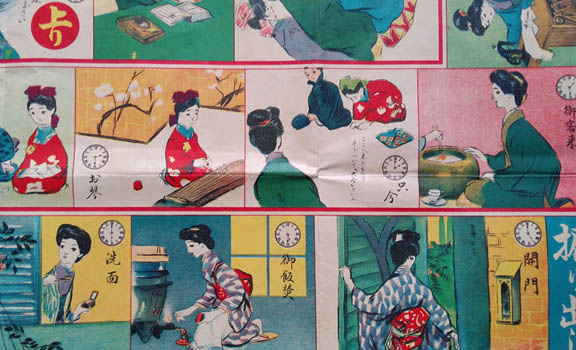
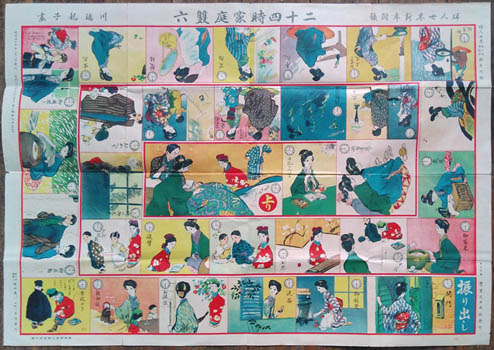
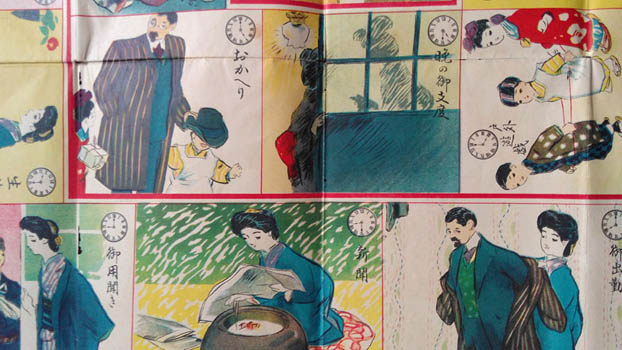
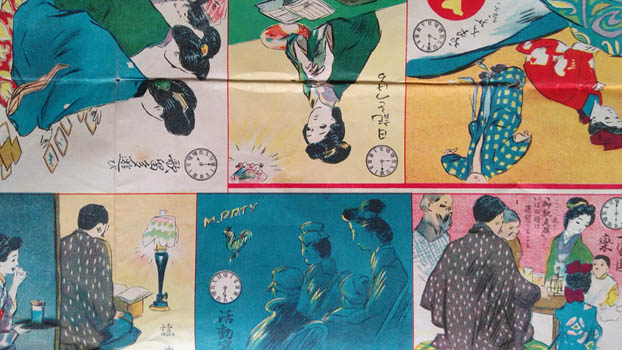

Kawabata Ryushi [Nijuyon Toki Katei]. Tokyo, Fujin Sekai 1912 (Meiji 45). Colour broadside 54x78cm. A bit used, a few small holes in folds. Au$400
The new year gift from the magazine Fujin Sekai - Woman's World - charting the day in the busy but calm and most decorative life of the successful woman - wife and mother.
Kawabata's career took a curious turn during a 1913 stay in America to study western painting. Apparently he was so impressed with the Japanese art he saw in Boston he switched to being a Nihonga painter. Still, he remained being an illustrator for magazines for quite some time. As did most of the early to mid 20th century artists now revered.
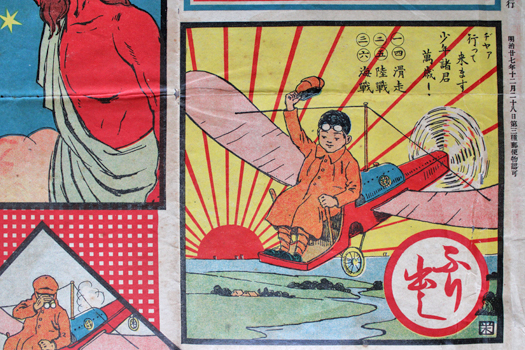
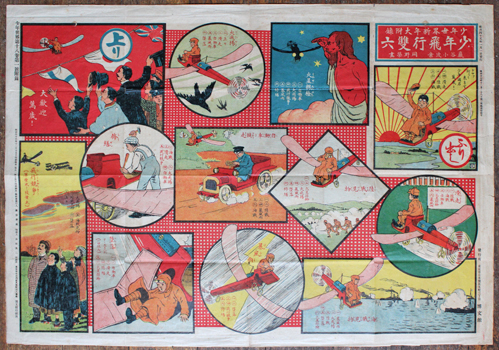
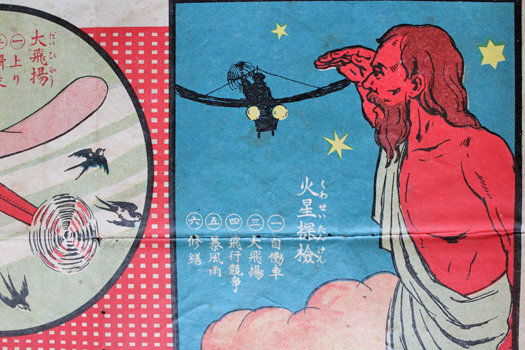
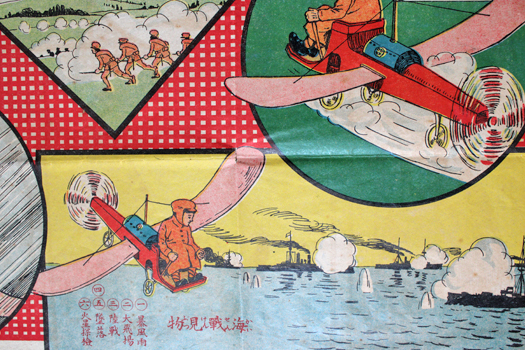

Okano Sakae [Shonen Hiko Sugoroku]. Tokyo, Shonen Sekai 1912 (Meiji 45). Colour broadside 55x79cm. Rumpled with several short tears around edges and along folds repaired. Au$250
This delightful illustrated journal of a boy's flying adventures was the new year gift from the boy's magazine Shonen Sekai. It's on a waxy paper that may have seemed a good idea when new but does not handle handling so well. This is the second best copy I've seen so far and I'm still looking.
Okano Sakae was one of the generation of artists who came through the western painting department of the Tokyo School of Fine Arts at the beginning of the century, later a pupil of Kuroda Seiki, and collaborator with fellow Hakubakai students on the five volume Nihon Meisho Shasei Kiko.
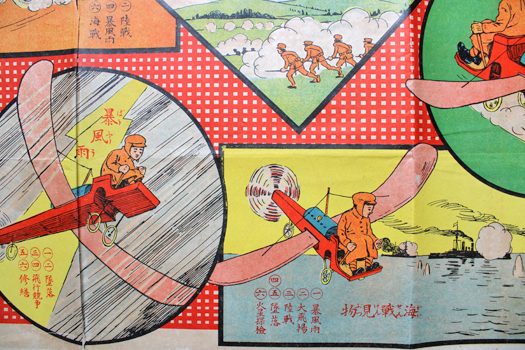

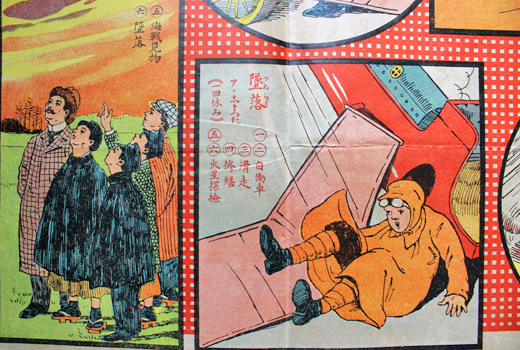
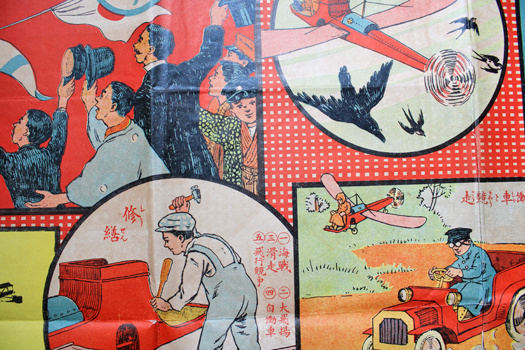

Okano Sakae [Shonen Hiko Sugoroku]. Tokyo, Shonen Sekai 1912 (Meiji 45). Colour broadside 55x79cm. With some short tears around edges and along folds repaired. Pretty good. Au$400
This delightful illustrated journal of a boy's flying adventures was the new year gift from the boy's magazine Shonen Sekai. It's on a waxy paper that may have seemed a good idea when new but does not handle handling so well. This is very much the best copy I've seen so far, not that I've seen many.
Okano Sakae was one of the generation of artists who came through the western painting department of the Tokyo School of Fine Arts at the beginning of the century, later a pupil of Kuroda Seiki, and collaborator with fellow Hakubakai students on the five volume Nihon Meisho Shasei Kiko.
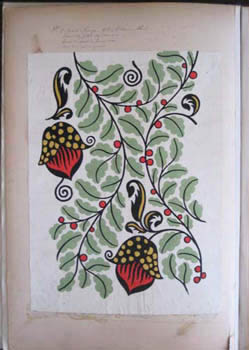
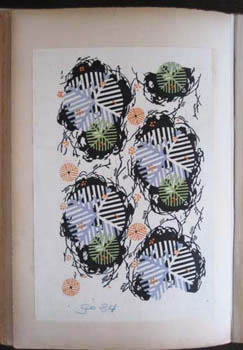
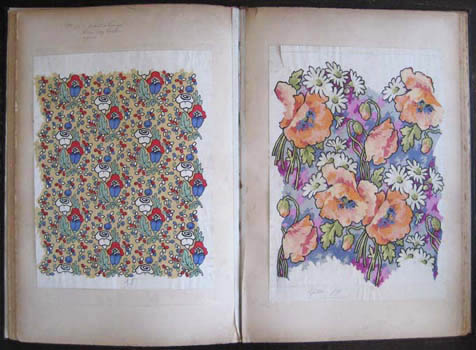
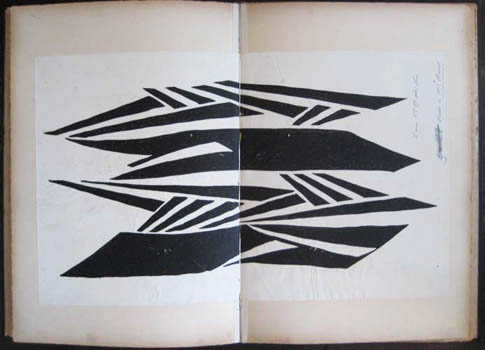

Design. An album of designs for textiles and/or paper. c1913-1920's? Large folio cloth [620x430mm]; 24 card leaves with 39 mounted original colour block prints (3 double page). Expected signs of use but nothing drastic; one print removed. Au$1200
Doubtless the designer's album of designs, these are proof prints from the blocks, each show the shape where the repeat pattern fits. The first pages are annotated with details of the client ('Achete a George. 9 Rue St Fiacre Paris' - in earlier decades this was the home of a calico manufacturer, which makes sense, and now houses a public relations firm and Ella Bache, which is neither here nor there) and the engraver (Gillet, sometimes in concert with someone else); the details dwindle as the album proceeds until we reach the large and dramatic geometric design in black and white which was "vendu a Mrs Bosset".
Dating these designs to 1913 would seem foolish but for the first few leaves being dated 1913 in the top corner; two or three are dull, traditional floral patterns but the rest, while by no means radical avant garde, would sit more happily in the next decade or two - some are really quite stylish. The theme is floral, or at least botanical although one is based on a Chinese cloud pattern; several are oriental in style or inspiration and one is a very stylish piece of Japanese abstraction.
I'm pretty sure this is the work of a Japanese designer in Paris, partly because it most recently came from Tokyo and partly because of the modern simplicity of several designs.
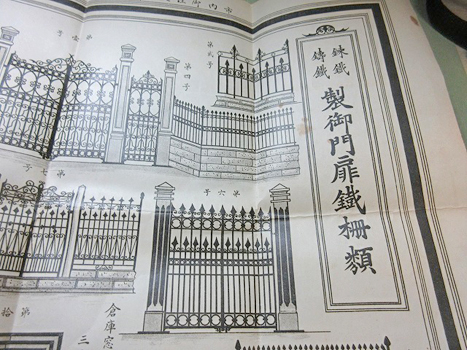
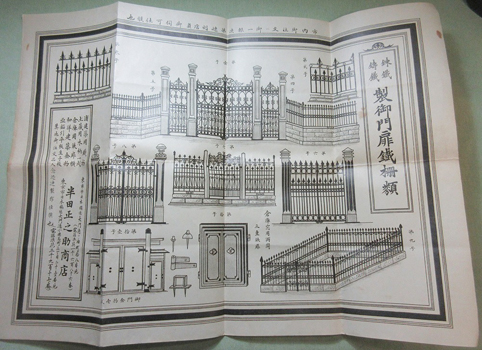
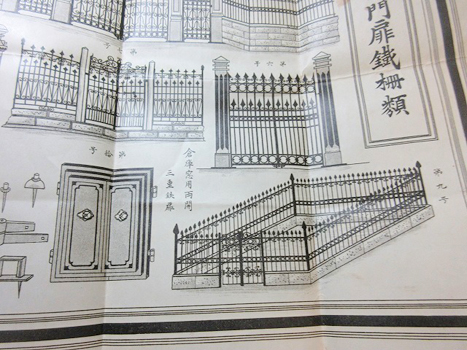
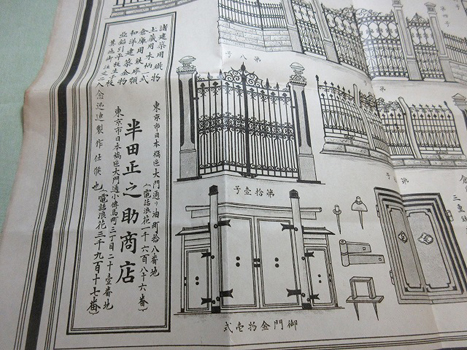

Catalogue - Iron gates, fences &c. Handa Shonosuke Shoten. [Sentetsuseio Monpi Tetsusakurui?]. Tokyo, Handa Shonosuke Shoten [c1913]. Lithograph broadside 40x56cm. A couple of small blotches, still a nice copy. Au$100
A handsome array of iron gates, fences and doors. Very similar - but not quite the same - to a broadside from the same place dated 1913.
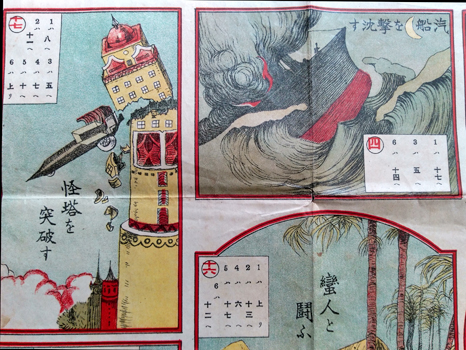
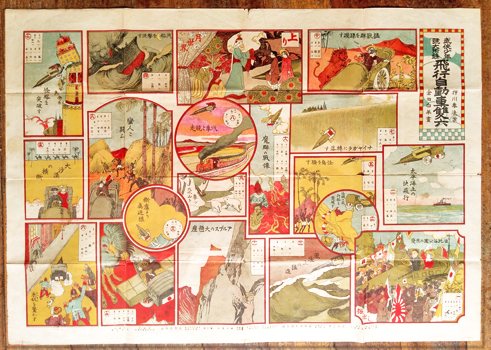
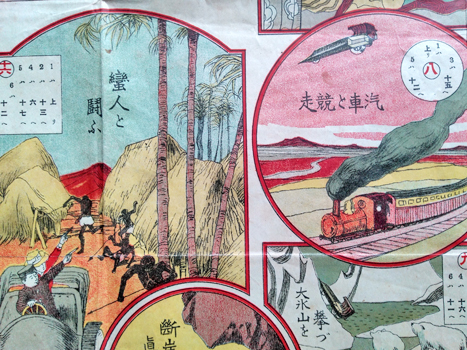
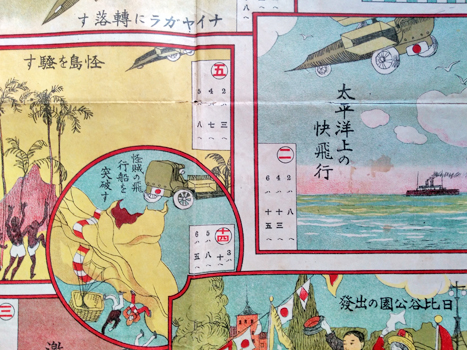

Kurata Hakuyo. [Hiko Jidosha Sugoroku]. Tokyo, Bukyo Sekai Sha 1913 (Taisho 2). Colour broadside 55x78cm. Used, with some small holes in folds and a repaired tear; quite acceptable. Au$400
This rare and captivating game was the new year gift from the magazine Bukyo Sekai. We follow two kids as they wreak havoc round the world in their flying car. Like all well prepared kids they packed their revolvers, handy when a lion attacks from one side and tigers from the other; likewise unfriendly black folk and what I take to be a roc.
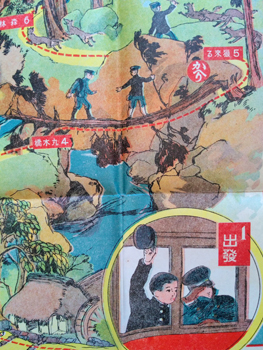
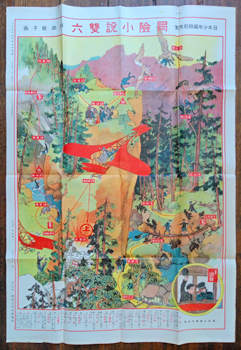
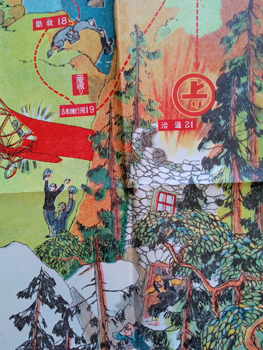
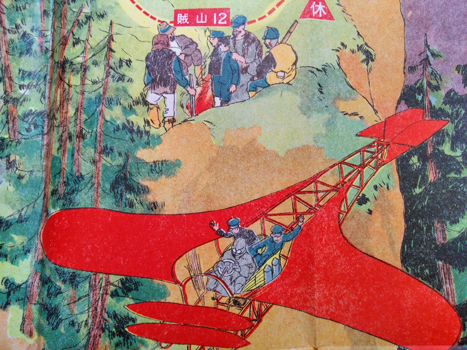

Kawabata Ryushi. [Boken Shosetsu Sugoroku]. Tokyo, Nihon Shonen 1913 (Taisho 2). Colour broadside 79x54cm. A few small holes in the folds; pretty good. Au$300
The new year gift from the boys' magazine Nihon Shonen is called an adventure novel and so it is: action packed and perilous from start to finish.
Kawabata's career took a curious turn during a 1913 stay in America to study western painting. Apparently he was so impressed with the Japanese art he saw in Boston he switched to being a Nihonga painter. Still, he remained being an illustrator for magazines for quite some time. As did most of the early to mid 20th century artists now revered.
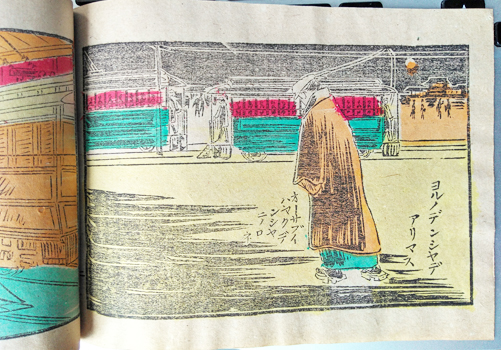
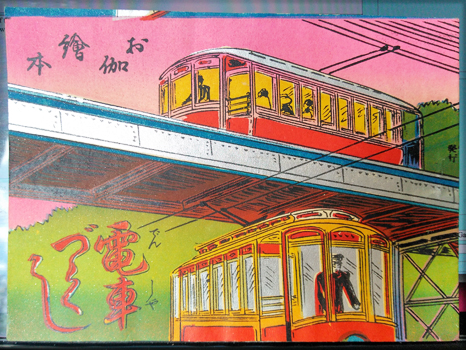
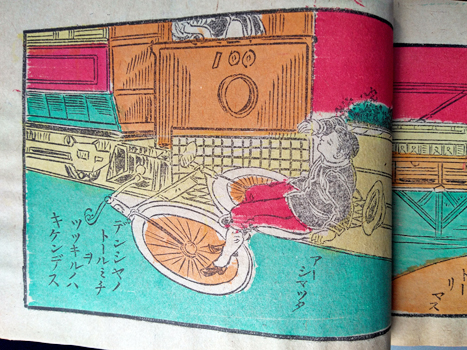
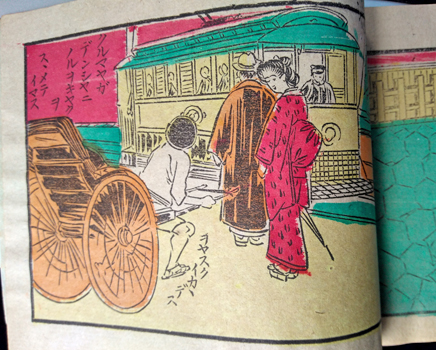

Trams (streetcars). : [Otogi Ehon : Densha-Dzukushi]. Tokyo, Seibido? 1914 (Taisho 3). 12x17cm publisher's woodblock colour illustrated wrapper; four double folded leaves with eight colour woodblock prints. An outstanding copy. Au$200
The quality of printing in this celebration of the tram goes down hill once we're past the front cover but the cover is worth it, what with the silver printing and sprinkles. And inside there is a too rarely seen view of a boy being knocked off his bike.
This is maybe not properly a modern akahon (red book), the ultra cheap and lurid kids books that came out of Osaka but it is a blood relation.
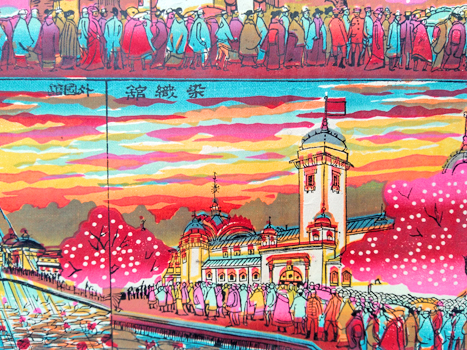
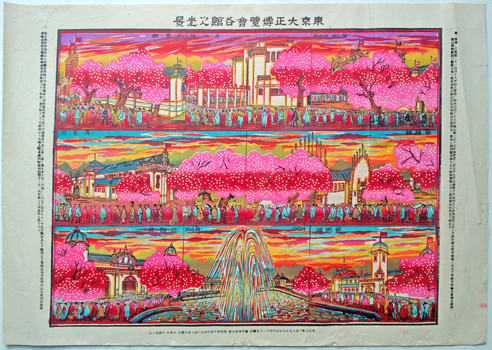
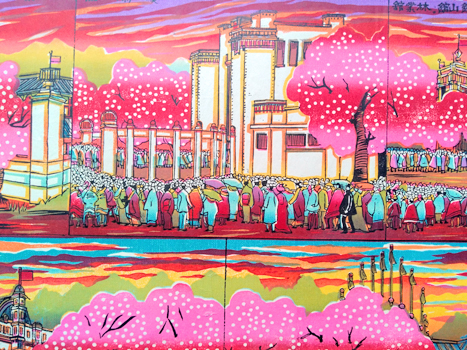
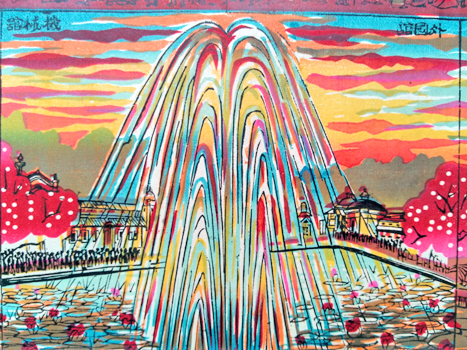

Exhibition - Tokyo 1914. [Tokyo Taisho Hakurankai Kaku Kan no Kokei] Tokyo, Shobundo March 1914 (Taisho 3). Colour lithograph 39x55cm. A bit rumpled along the bottom edge with a couple of short tears in the margins. Rather good. Au$150
Fine views of the psychedelic Taisho exposition - to celebrate the enthronement of the emperor - held in Ueno Park, which introduced any number of technical advances to the Japanese, including an escalator and a cable car. Once the eyes stop watering these acid trip views of late Meiji and Taisho Japan start to make sense. They may have started as a cynical grab at attention for cheap, often nasty, prints but after a while they become a celebration of being in a place and time so exciting that no portrait can be too brightly, too impossibly, coloured.
Photographs may be in some way a more reliable record but no photographer could so capture the thrill of being out and about in Tokyo on a Taisho afternoon.
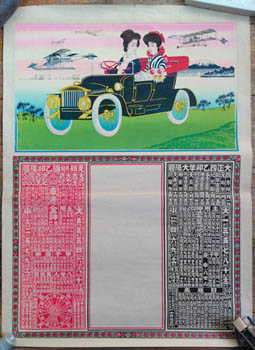
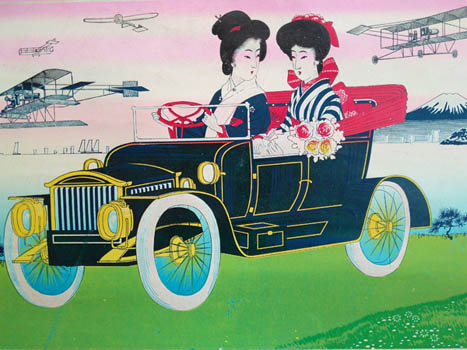

Specimen hikifuda. Hikifuda of a woman driving a motor car. n.p. [1914]. Colour woodcut 52x38cm. Stab holes in the margin showing it was once in an album; a little browned and minor signs of use. Rather good. Au$500
An shockingly early picture of a Japanese woman driving a car. Cars and planes were the password for modernity through the Taisho, especially in advertising like this, but sleek women were driven by sleek husbands or chauffeurs. This is radical stuff. It's not until well into the twenties that women behind the wheel became common. Common but not really acceptable. Cars were driven by Mogas - modern girls - louche young women with bobbed hair and short skirts, flappers. The history of early Japanese women motorists, in English, is blank. Can some expert out there help?
These hikifuda - small posters or handbills - were usually produced with the text panel blank. The customer, usually a retailer, had their own details over printed. The handy calendar is for 1915.
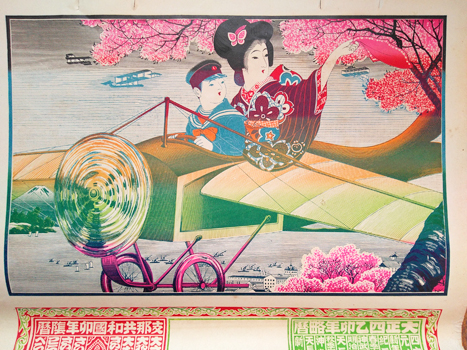
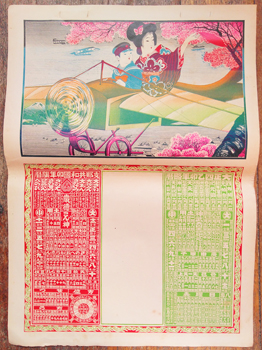
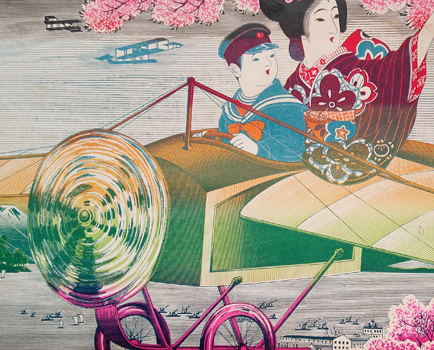

Specimen hikifuda. Large hikifuda of a boy flying his mother in a monoplane. n.p.n.d. (1914). Colour lithograph 53x38cm. Stab holes in the top margin, catalogue number on the back, showing it was once in a specimen book. Folded rather than creased. Au$200
That woman and child are modelled on the crown princess and her first son - Hirohito - as they were a few years before. She is adventurous enough to go skylarking but still the boy must drive. Around and below are most of the things that make Japan Japan - cherry blossoms, industry and Fuji.
Hikifuda - small posters or handbills - were usually produced with the text panel blank. The customer, usually a retailer, had their own details over printed, so the same image might sell fine silk or soy sauce. This one is double the standard size; the timetable or calendar is for 1915.
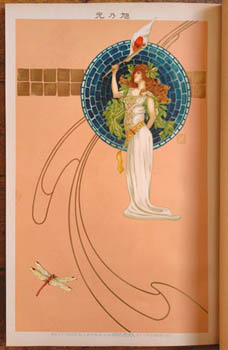
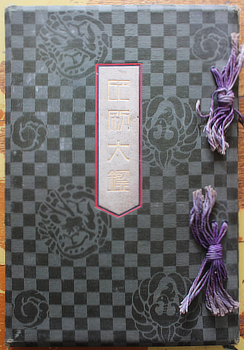
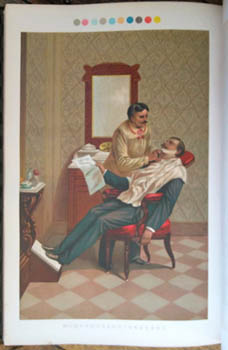
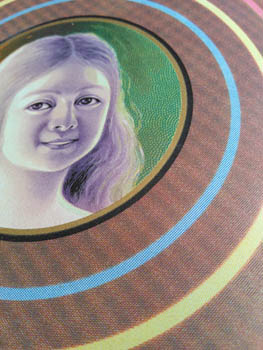

Printing. [Insatsu Taikan]. Osaka, Nihon Insatsu Kaisha 1915 (Taisho 4). Folio (39x27cm) publisher's patterned silk over bevelled boards with cord ties (silk worn through at the corners); 12 preliminary leaves including two colour plates and a preface in French, 96 specimen leaves by different printers on different papers is a variety of techniques: chromolithography, four colour process, photo engraving, gravure, embossing, etc, with two plates on metal sheets; 11 more leaves at the end including a couple of plates. Minor adhesion with a couple of the chromolithos, causing a tear on the facing leaf of one. Inner hinges have cracked at some time and repaired not so neatly. Au$1300
A luxurious bit of showing off by the Japanese printing industry announcing that they have done their apprenticeship with western printers and now match them in skill. Fine printing, book work, advertising ... some kitsch and some very smart.
I now discover this exists in at least three states: one with silk covers and 101 specimens, this one with silk covers and 96 specimens, and one with mock silk printed boards with fewer preliminaries and 86 specimens. I presume this changed as specimens ran out. I've also realised that the cord ties are decorative: they are fastened under the endpapers in each cover and don't go through the book. Why I didn't notice this before ... I hang my head in shame.
For such a grand book this was not distributed as widely as you might expect. Worldcat finds five copies, all following the same catalogue entry dated 1916. I know that the two Australian copies are bound in silk and are dated 1915 and one US copy is the printed cover version; I don't know what the other two US copies are. CiNii finds five copies in Japanese libraries, and my searches of specialist libraries found no more.

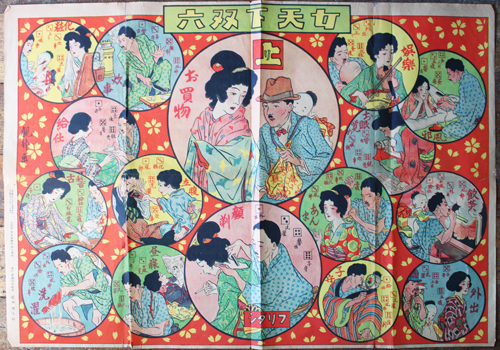
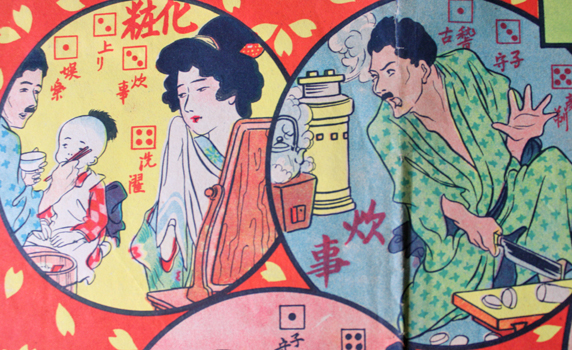
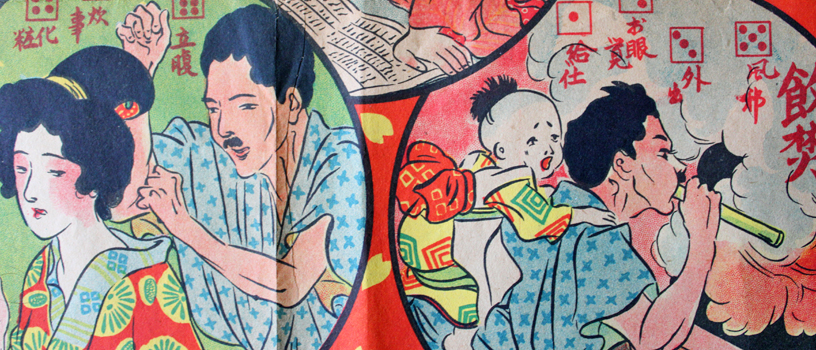

Feminist Sugoroku. Maeda Masujiro. [Onna Tenko Sugoroku]. Osaka 1915 (Taisho 4). 53x77cm colour broadside. Natural browning of the paper, small holes and tears with some repairs. Au$1100
Rare and wonderful. Not the greatest copy maybe, but until someone sees a second copy we won't know. Onna Tenko - woman's world - can be translated as 'petticoat government' and graphic reversals of male and female was long a favourite tool of the anti-feminist anti-suffragists. Which has long made me wonder: the horror of men at having to fill women's roles and do women's tasks is surely the most persuasive argument for equality.
As unlikely as it seems in Japan in 1915 when women were forbidden any political activity, I'm almost convinced that the argument here is for women, why else would they have the arrogant, exasperated, indifferent, harsh, demanding expressions that they must see on men's faces every day.
As far as I can find, Maeda Masujiro is just a name on a couple of later samurai sugoroku that don't look a lot like this. This one seems to have a fair bit of Rakuten in it so I guess he grew into more burly he-man types.
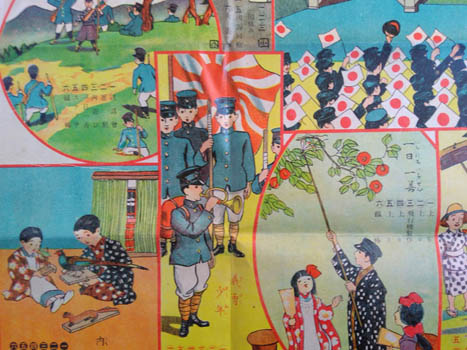
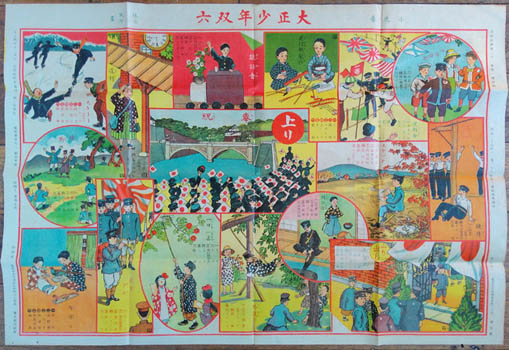
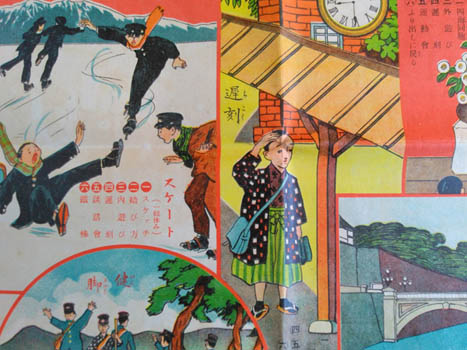
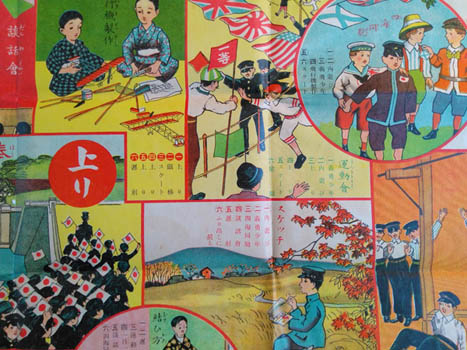

Kobayashi Eijiro. [Taisho Shonen Sugoroku]. Tokyo, Shonen Sekai 1915 (Taisho 4). Colour broadside 54x79cm. A touch browned and minor signs of use; pretty good. Au$250
A gift from the boys' magazine Shonen Sekai and, as always with boys' sugoroku, packed with excitement and adventure. Girls sometimes get to watch in awe.
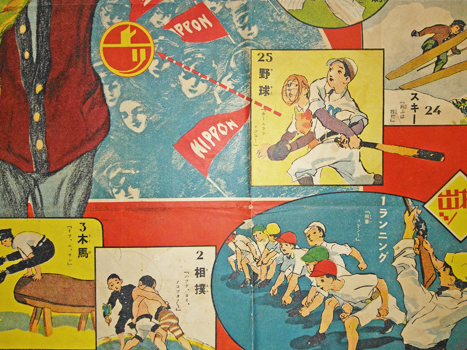
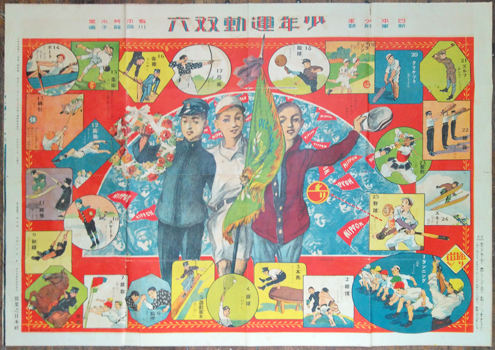
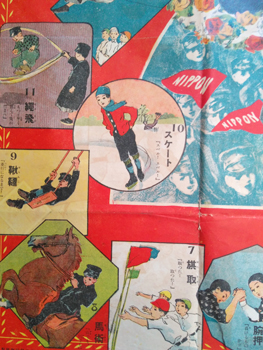
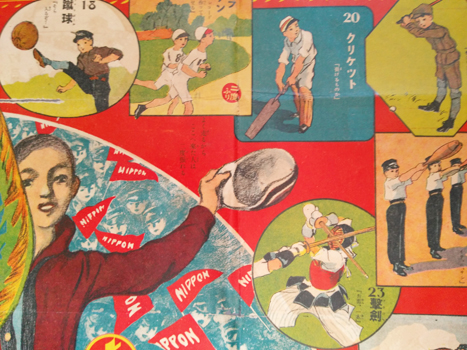

Sugoroku. Kawabata Ryushi. [Shonen Undo Sugoroku]. Tokyo, 1916 (Taisho 5). Colour printed broadside 54x79cm. Some separations along folds with some proper repairs. An ok copy. Au$125
The New Year gift from the magazine Nihon Shonen - Japanese Boy. A splendid vision of the life of the active, enthusiastic Japanese boy: success and fame. Compare this with contemporary sugoroku for girls.
Kawabata's career took a curious turn during a 1913 stay in America to study western painting. Apparently he was so impressed with the Japanese art he saw in Boston he switched to being a Nihonga painter. Still, he remained being an illustrator for magazines for quite some time. As did most of the early to mid 20th century artists now revered.
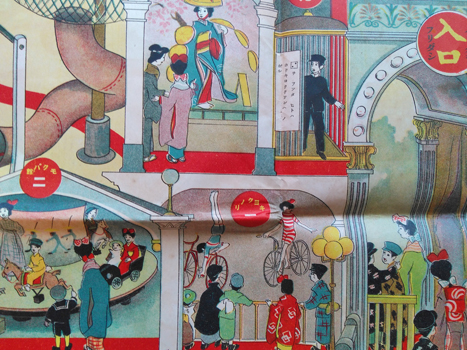
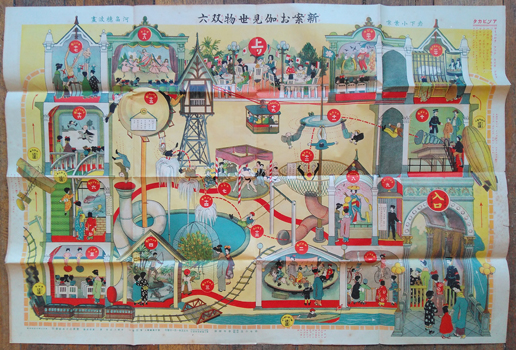
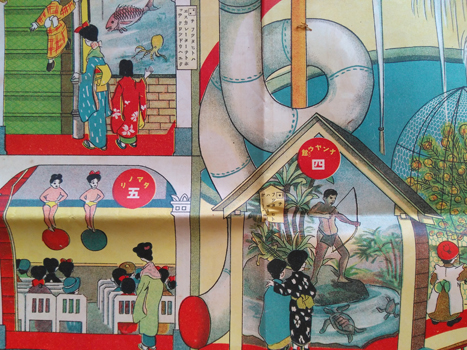
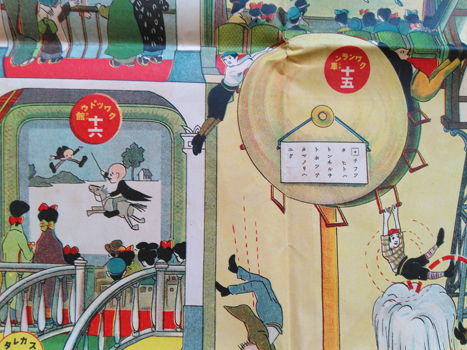

Kawabata Honami [Shin'an Otogi Misemono Sugoroku]. Tokyo, Yonen no Tomo 1916 (Taisho 5). Colour broadside 53x78cm. Edges nibbled, some browning and a couple of small flaws but pretty good. Au$485
This utopian view of a kids' paradise was the New Year gift from the magazine Yonen no Tomo. It's hard to find. This is a model for a new kind of fun palace that has a lot in common with the modern department store, which usually had fun for kids and a cafe at the top. In this case all the boring stuff - like clothes - has been stripped out and the whole emporium turned over to fun.

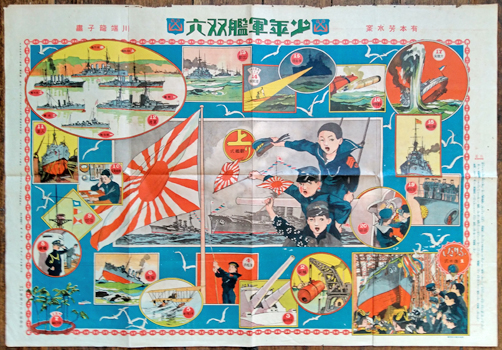
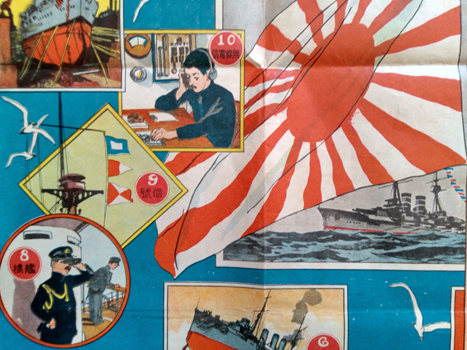
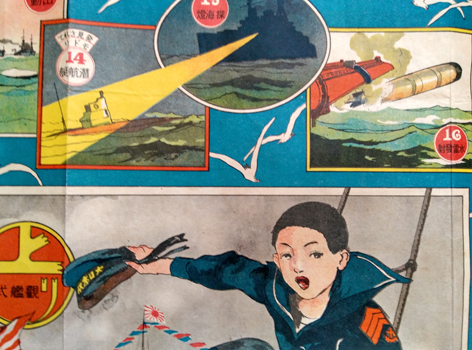

Kawabata Ryushi. [Shonen Gunkan Sugoroku]. Tokyo,Nihon Shonen 1917 (Taisho 6) 54x78cm colour broadside. Top edge nibbled, minor signs of use. Au$425
A boy's celebration of the navy; this game was the new year gift from the magazine Nihon Shonen.
Kawabata's career took a curious turn during a 1913 stay in America to study western painting. Apparently he was so impressed with the Japanese art he saw in Boston he switched to being a Nihonga painter. Still, he remained being an illustrator for magazines for quite some time. As did most of the early to mid 20th century artists now revered.
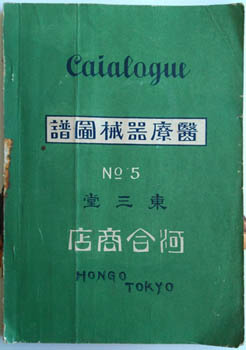
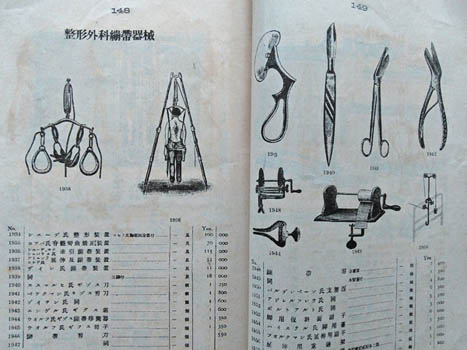
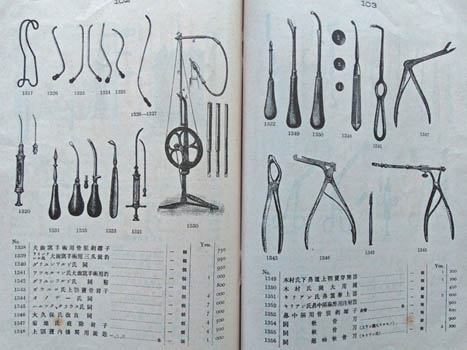
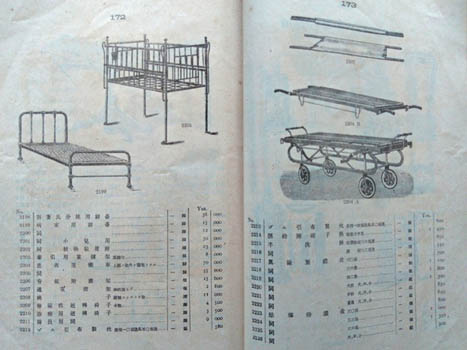

Catalogue - medical and dental equipment. Kawai Shoten, Tokyo. Caialogue [sic] (?) No. 5. [Iryokikkai Zufu?]. Tokyo, Kawai Shoten 1917 (Taisho 6). 22x15cm publisher's printed wrapper (covers somewhat shabby & ragged); [4],200pp, illustrated throughout. A used but decent copy. Au$200
An extensive catalogue of medical and dental equipment and all the necessary ancillaries - furniture, laboratory equipment, a few artificial limbs, and so on. This is Kawai's fifth catalogue but I can't find a record of any of them.
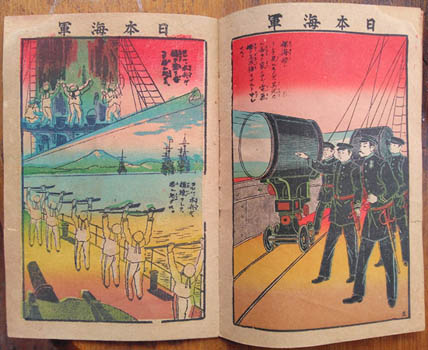
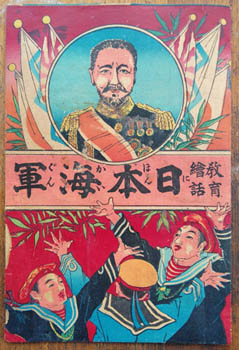
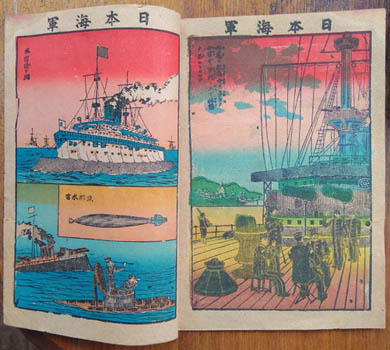

- [Nihon Kaigun - Kyoiku Ebanashi]. Osaka, Enomoto 1917 (Taisho 6). 19x13cm publisher's colour illustrated wrapper; 10pp including wrapper, seven full page colour illustrations. Expected browning of the paper, short marginal tear and a nibble from the front wrapper; pretty good for one of these cheap booklets. Au$165
The glory of the Japanese navy for kids in the eye watering colours of akahon (red book) tradition. This is apparently the fifth edition, it first appeared in 1915.
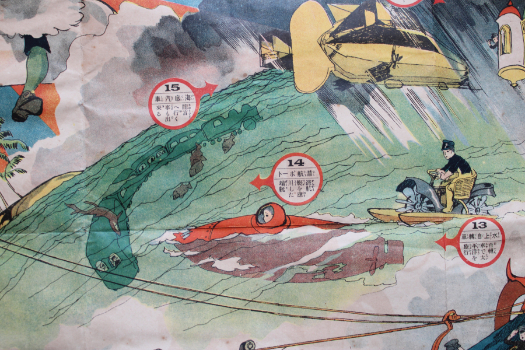
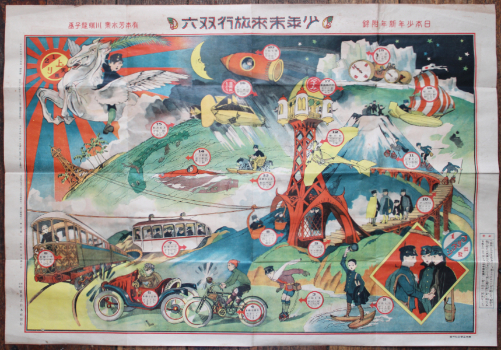
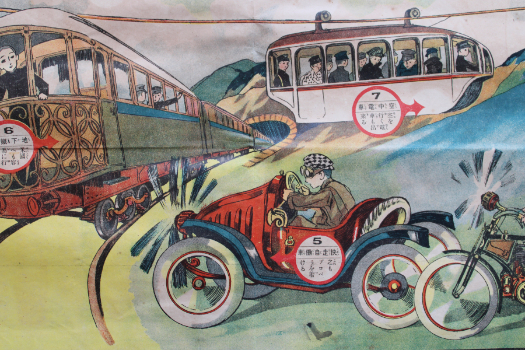
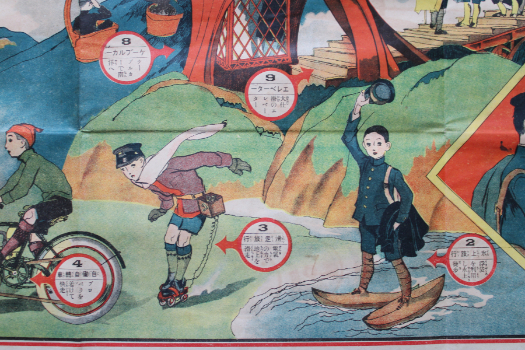

Sugoroku. Kawabata Ryushi. [Shonen Mirai Ryoko Sugoroku]. Tokyo, Nihon Shonen 1918 (Taisho 7). Colour broadside 78x54cm. Some browning and minor signs of use; not bad. Au$500
The New Year gift from the boy's magazine Nihon Shonen. A view of travel in the future, this is among my favourites of the travel adventure sugoroku and hard to find in anything like one piece. Doubtless it was a favourite with many others too.
Kawabata did several of the best, most captivating, sugoroku of the period. His career took a curious turn during a 1913 stay in America to study western painting. Apparently he was so impressed with the Japanese art he saw in Boston he switched to being a Nihonga painter. Still, he remained being an illustrator for magazines for quite some time. As did most of the early to mid 20th century artists now revered.
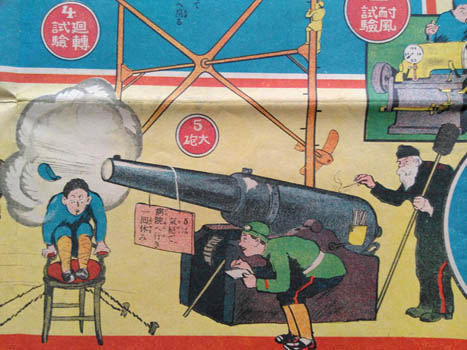
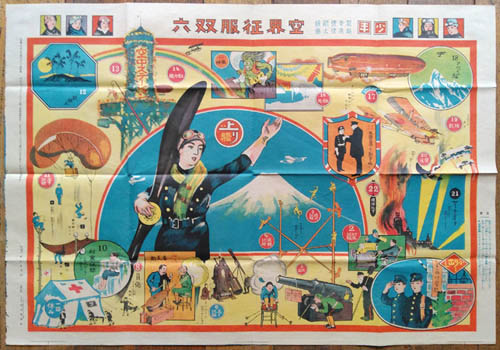
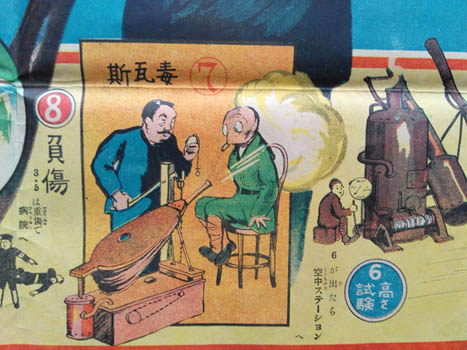
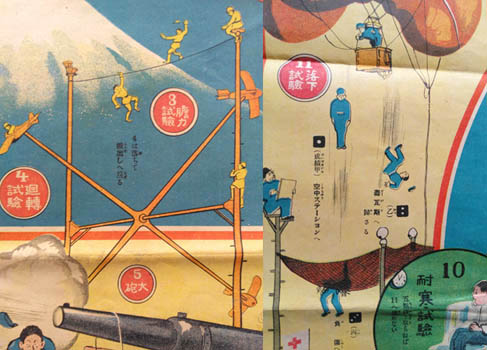

Fujiwara Ritsuta. [Sorakai Seifuku Sugoroku]. Tokyo, Shonen 1918 (Taisho 7). Colour broadside 79x55cm. A nice copy. Au$480
A delight - the rigours of flying school explained with the careful attention to truth and detail of a Heath Robinson. This was the new year gift from the magazine Shonen.
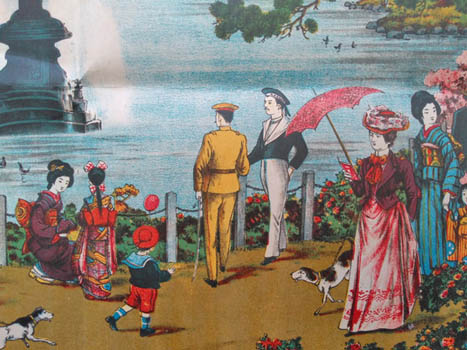
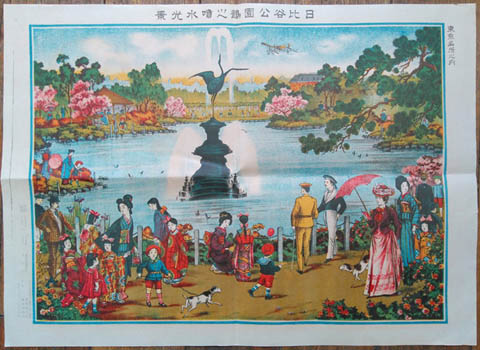
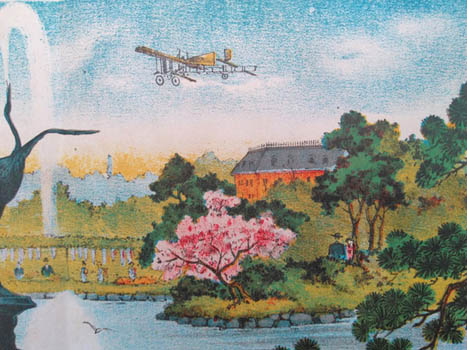
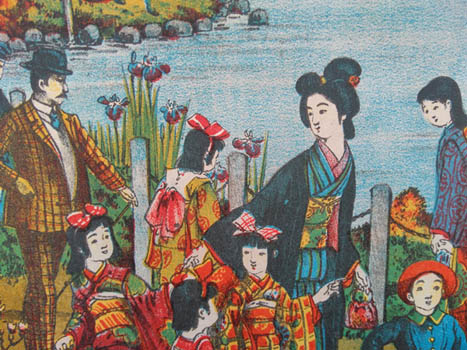

[Hibiyakoen Tsuru no Funsui Kokei]. Tokyo 1918 (Taisho 7) Colour lithograph 39x55cm. Folded, a nice copy. Au$200
There is some warp in time operating around the Hibaya Park fountain where men and women from their grandparents' generation promenade with present day residents and pioneer aviators from the previous decade appear overhead. Only a couple of children seem to notice.
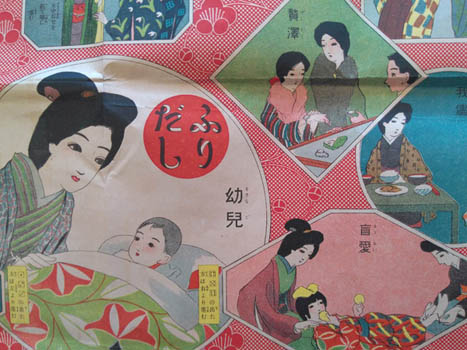
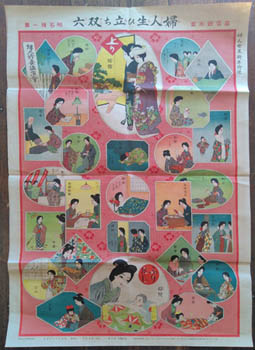
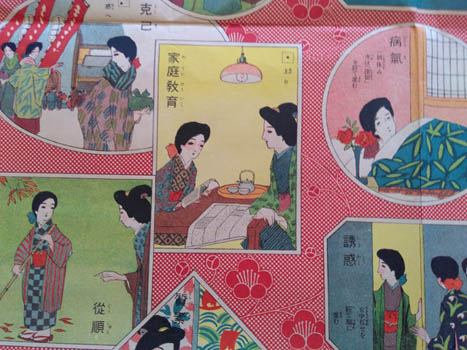
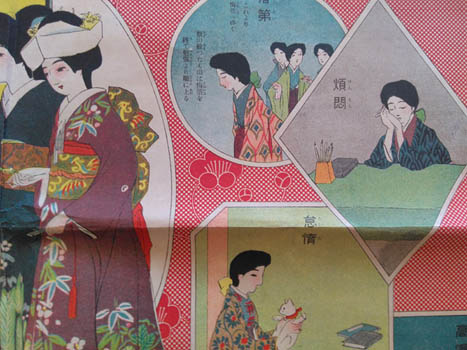

Akashi Seiichi. [Fujin Nama Hi Tate Sugoroku]. Tokyo, Fujin Sekai 1918 (Taisho 7). Colour broadside 78x54cm. A bit of unnecessary folding, quite a good copy. Au$220
A fortunate life for a girl from cradle to bride. She must have opened her mouth and said something during these years but as she is well brought up we never see her lips move. This was the new year gift from the magazine Fujin Sekai - Woman's World.
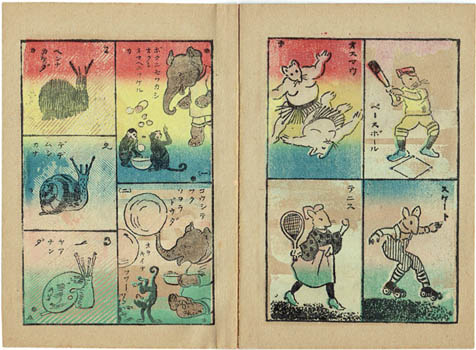
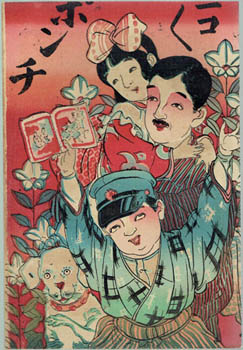

[Nikonikoponchi]. Osaka, Enomoto shoten 1919 (Taisho 8). 21x14cm publisher's colour litho wrapper; 10pp including wrapper; colour lithograph illustrations throughout. Natural browning of the cheap paper, an excellent copy. Au$80
Short comic strip gags printed in that style that makes you reach for your 3D glasses. Maybe not the finest printing but these akahons (red books) - cheap and gaudy - do manage to catch the thrill of being alive in a time when everything is fun. This may be a reprint; published a couple of years after the first.
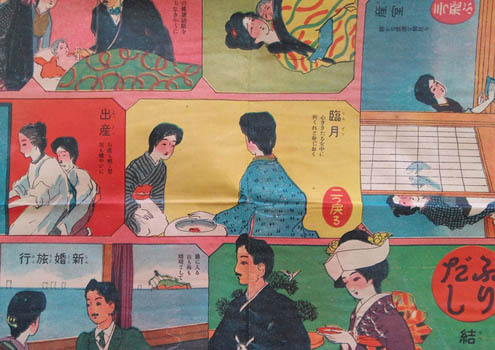
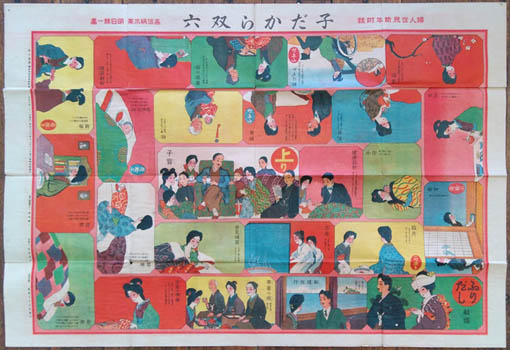
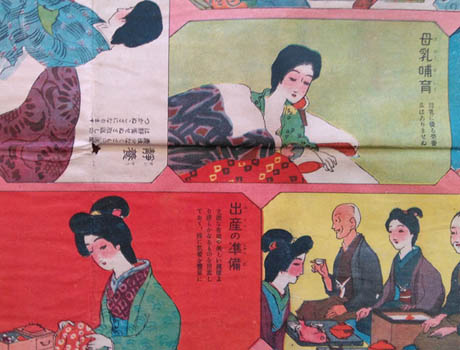
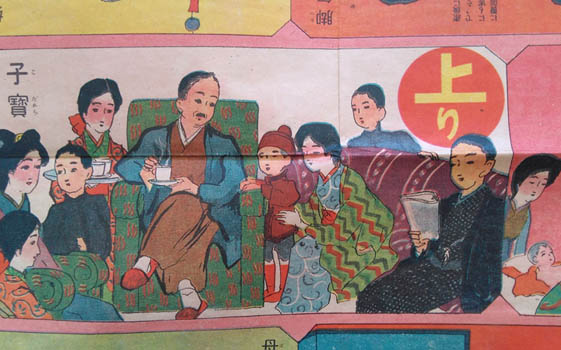

Akashi Seiichi. [Kodakara Sugoroku]. Tokyo, Fujin Sekai 1919 (Taisho 8). Colour printed broadsheet 54x79cm. A bit used, some browning and a couple of small holes in folds; pretty good. Au$300
The new year gift from the magazine Fujin Sekai - Woman's World - is a colourful hymn to the joys of having children.
  1 2 3 [4] 5 6 7 1 2 3 [4] 5 6 7   |